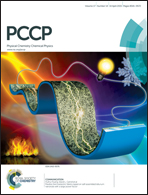The modification of ferroelectric LiNbO3(0001) surfaces using chromium oxide thin films
Abstract
The impact of ferroelectric polarization on the chemical and electronic properties of atomically thin layers of non-polar chromium oxide deposited on positively and negatively poled LiNbO3(0001) was studied. Chromium(III) oxide readily forms on LiNbO3; however, annealing at high temperatures was required to maintain well-ordered films as the thickness increased. Prolonged heating at these temperatures caused Cr diffusion into the LiNbO3 substrate. Comparing Cr 2p X-ray photoelectron spectroscopy (XPS) peak positions as a function of temperature and substrate polarization revealed no evidence of shifts from the peak positions expected for Cr2O3. The lack of any band offset between Cr2O3 on the oppositely poled surface suggests that charge compensation of the ferroelectric substrate occurs at least predominantly at the surface of the film, as opposed to the film-substrate interface. No evidence of shifts due to oxidation or reduction of the Cr was observed indicating that charge compensation did not involve a change in the ionic state of the Cr. Exposing the films to reactive oxygen species emitted from an oxygen plasma, however, caused a distinct high binding energy shoulder on the Cr 2p3/2 XPS peaks that could be associated with oxygen adsorption on surface Cr and concomitant oxidation to Cr5+. This feature was used to gauge the concentration of O adatoms on the surfaces as a function of temperature for oppositely poled substrates; these measurements did not reveal any significant polarization dependence for oxygen desorption. Further, temperature programmed desorption measurements for a Cr2O3 film on α-Al2O3 showed a similar trend in O2 desorption. Therefore, it is concluded that the reactivity of Cr2O3 toward O is at least largely independent of substrate polarization despite data suggestive of charge compensation at the film surfaces.


 Please wait while we load your content...
Please wait while we load your content...